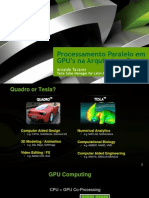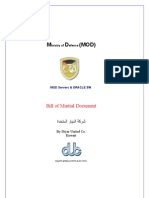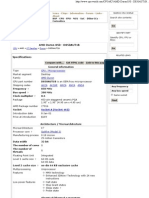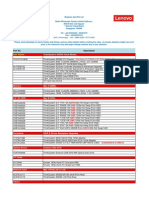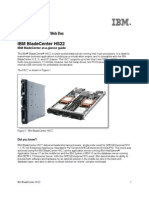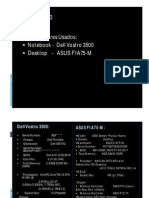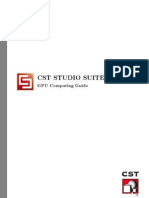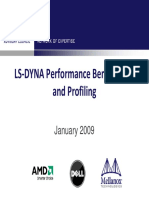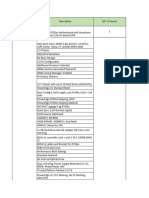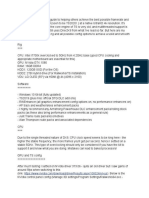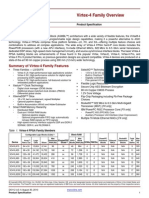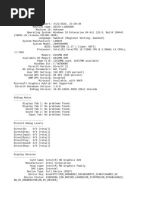Cuda Maxwell 3 D
Cuda Maxwell 3 D
Uploaded by
robert_lascuCopyright:
Available Formats
Cuda Maxwell 3 D
Cuda Maxwell 3 D
Uploaded by
robert_lascuOriginal Title
Copyright
Available Formats
Share this document
Did you find this document useful?
Is this content inappropriate?
Copyright:
Available Formats
Cuda Maxwell 3 D
Cuda Maxwell 3 D
Uploaded by
robert_lascuCopyright:
Available Formats
Stan Posey, HPC Industry Development NVIDIA, Santa Clara, CA, USA sposey@nvidia.
com
NVIDIA Introduction and HPC Evolution of GPUs
Public, based in Santa Clara, CA | ~$4B revenue | ~5,500 employees
Founded in 1999 with primary business in semiconductor industry
Products for graphics in workstations, notebooks, mobile devices, etc. Began R&D of GPUs for HPC in 2004, released first Tesla and CUDA in 2007
Development of GPUs as a co-processing accelerator for x86 CPUs
HPC Evolution of GPUs
2004: Began strategic investments in GPU as HPC co-processor 2006: G80 first GPU with built-in compute features, 128 cores; CUDA SDK Beta 2007: Tesla 8-series based on G80, 128 cores CUDA 1.0, 1.1
2008: Tesla 10-series based on GT 200, 240 cores CUDA 2.0, 2.3
2009: Tesla 20-series, code named Fermi up to 512 cores CUDA SDK 3.0
3 Generations of Tesla in 3 Years
How NVIDIA Tesla GPUs are Deployed in Systems
Data Center Products
Tesla M205 / M2070 Adapter Tesla S2050 1U System
Workstation
Tesla C2050 / C2070 Workstation Board
GPUs
Single Precision
1 Tesla GPU
4 Tesla GPUs
1 Tesla GPU
1030 Gigaflops
515 Gigaflops 3 GB / 6 GB 148 GB/s
4120 Gigaflops
2060 Gigaflops 12 GB (3 GB / GPU) 148 GB/s
1030 Gigaflops
515 Gigaflops 3 GB / 6 GB 144 GB/s
3
Double Precision
Memory Memory B/W
Engineering Disciplines and Related Software
Computational Structural Mechanics (CSM) implicit for strength (stress) and vibration
Structural strength at minimum weight, low-frequency oscillatory loading, fatigue
ANSYS; ABAQUS/Standard; MSC.Nastran; NX Nastran; Marc
Computational Structural Mechanics (CSM) explicit for impact loads; structural failure
Impact over short duration; contacts crashworthiness, jet engine blade failure, bird-strike
LS-DYNA; ABAQUS/Explicit; PAM-CRASH; RADIOSS
Computational Fluid Dynamics (CFD) for flow of liquids (~water) and gas (~air)
Aerodynamics; propulsion; reacting flows; multiphase; cooling/heat transfer
ANSYS FLUENT; STAR-CD; STAR-CCM+; CFD++; ANSYS CFX; AcuSolve; PowerFLOW
Computational Electromagnetics (CEM) for EM compatibility, interference, radar
EMC for sensors, controls, antennas; low observable signatures; radar-cross-section
ANSYS HFSS; ANSYS Maxwell; ANSYS SIwave; XFdtd; FEKO; Xpatch; SIGLBC; CARLOS; MM3D 4
Motivation for CPU Acceleration with GPUs
GPU Progress Status for Engineering Codes
GPU Status
Available Today
Structural Mechanics
ANSYS Mechanical AFEA Abaqus/Standard (beta) LS-DYNA implicit Marc
Fluid Dynamics
AcuSolve Moldflow Culises (OpenFOAM) Particleworks CFD++ LS-DYNA CFD
Electromagnetics
Nexxim EMPro CST MS XFdtd SEMCAD X Xpatch
Release Coming in 2011 Product Evaluation
RADIOSS implicit PAM-CRASH implicit MD Nastran NX Nastran LS-DYNA Abaqus/Explicit
CFD-ACE+ FloEFD Abaqus/CFD
Research Evaluation
FLUENT/CFX STAR-CCM+
HFSS 6
GPU Considerations for Engineering Codes
Initial efforts are linear solvers on GPU, but its not enough
Linear solvers ~50% of profile time -- only 2x speed-up is possible More of application will be moved to GPUs in progressive stages
Most codes use a parallel domain decomposition method
This fits GPU model very well and preserves costly MPI investment
All codes are parallel and scale across multiple CPU cores
Fair GPU vs. CPU comparisons should be CPU-socket-to-GPU-socket Comparisons presented here are made against 4-core Nehalem
7
Leading ISVs Who Develop Engineering Codes
ISV
ANSYS SIMULIA LSTC MSC.Software CD-adapco Altair Siemens ESI Group Metacomp ACUSIM Autodesk
Application
ANSYS CFD (FLUENT and CFX); ANSYS Mechanical; HFSS Abaqus/Standard; Abaqus/Explicit LS-DYNA MD Nastran; Marc; Adams STAR-CD; STAR-CCM+ RADIOSS NX Nastran PAM-CRASH; PAM-STAMP CFD++ AcuSolve Moldflow 8
GPU Priority by ISV Market Opportunity and Fit
#1 Computational Structural Mechanics (CSM) implicit for strength (stress) and vibration
ANSYS | ABAQUS/Standard | MSC.Nastran; Marc | NX Nastran | LS-DYNA | RADIOSS
Typical Computational Profiles of CSM Implicit
Tesla C2050 4x Faster DGEMM vs. QC Nehalem
DGEMM Improved 36% With CUDA 3.2 (Nov 10)
Gflops
350 300 250 200 150 100 50 0
64 x 64 384 x 384 704 x 704 1024 x 1024 1344 x 1344 1664 x 1664 1984 x 1984 2304 x 2304 2624 x 2624 2944 x 2944 3264 x 3264 3584 x 3584 3904 x 3904 4224 x 4224 4544 x 4544 4864 x 4864 5184 x 5184 5504 x 5504 5824 x 5824 6144 x 6144 6464 x 6464 6784 x 6784 7104 x 7104 7424 x 7424 7744 x 7744 8064 x 8064 8384 x 8384
DGEMM: Multiples of 64
cuBLAS 3.1: NVIDIA Tesla C1060, Tesla C2050 (Fermi) MKL 10.2.4.32: Quad-Core Intel Xeon 5550, 2.67 GHz
cuBLAS 3.2: NVIDIA Tesla C1060, Tesla C2050 (Fermi) MKL 10.2.4.32: Quad-Core Intel Xeon 5550, 2.67 GHz 10
Basics of Implicit CSM Implementations
Implicit CSM deployment of a multi-frontal direct sparse solver
Large Dense Matrix Fronts
Schematic Representation of Stiffness Matrix that is Factorized in the Solver
Small Dense Matrix Fronts
11
Basics of Implicit CSM Implementations
Implicit CSM deployment of a multi-frontal direct sparse solver
Large Dense Matrix Fronts
Upper threshold: Fronts too large for single GPU memory need multiple GPUs Lower threshold: Fronts too small to overcome PCIe data transfer costs stay on CPU cores
Small Dense Matrix Fronts
12
ANSYS Performance Study by HP and NVIDIA
HP ProLiant SL390 Server Configuration
Single server node 12 total CPU cores, 1 GPU 2 x Xeon X5650 HC 2.67 GHz CPUs (Westmere) 48 GB memory 12 x 4GB 1333 MHz DIMMs NVIDIA Tesla M2050 GPU with 3 GB memory RHEL5.4, MKL 10.25, NVIDIA CUDA 3.1 256.40 Study conducted at HP by Domain Engineering
HP SL390 Server
NVIDIA Tesla M2050 GPU
+
HP Z800 Workstation NVIDIA Tesla C2050 GPU
HP Z800 Workstation Configuration
2 x Xeon X5570 QC 2.8 GHz CPUs (Nehalem) 48 GB memory NVIDIA Tesla C2050 with 3 GB memory RHEL5.4, Intel MKL 10.25, NVIDIA CUDA 3.1 Study conducted at NVIDIA by Performance Lab
ANSYS Mechanical Model V12sp-5
Turbine geometry, 2,100 K DOF and SOLID187 FEs Single load step, static, large deflection nonlinear ANSYS Mechanical 13.0 direct sparse solver 13
ANSYS Mechanical for Westmere GPU Server
NOTE: Results Based on ANSYS Mechanical R13 SMP Direct Solver Sep 2010
3000
Xeon 5650 2.67 GHz Westmere (Dual Socket)
2656
ANSYS Mechanical Times in Seconds
Xeon 5650 2.67 GHz Westmere + Tesla M2050
Results from single HP-SL390 server node, 2 x Xeon X5650 2.67GHz CPUs, 48GB memory 12 x 4GB at 1333MHz, MKL 10.25; Tesla M2050, CUDA 3.1
V12sp-5 Model
2000
1.6x
1616
1000
Lower is better
1.5x
1062
NOTE: Scaling Limit to One 6-Core Socket
1.6x
0
668
1.3x
521
1 Core
2 Core 1 Socket
4 Core
6 Core
12 Core 2 Socket
- Turbine geometry - 2,100 K DOF - SOLID187 FEs - Static, nonlinear - One load step - Direct sparse
14
ANSYS Mechanical for Westmere GPU Server
NOTE: Results Based on ANSYS Mechanical R13 SMP Direct Solver Sep 2010
3000
Xeon 5650 2.67 GHz Westmere (Dual Socket)
2656
ANSYS Mechanical Times in Seconds
Xeon 5650 2.67 GHz Westmere + Tesla M2050
Results from single HP-SL390 server node, 2 x Xeon X5650 2.67GHz CPUs, 48GB memory 12 x 4GB at 1333MHz, MKL 10.25; Tesla M2050, CUDA 3.1 NOTE: Add a C2050 to use with 4 cores: now faster than 12, with 8 to use for other tasks
Lower is better
V12sp-5 Model
2000
4.4x
1000
1616
3.3x
1062
2.4x
606
0
494
668 438
1.5x
1.3x
448
521
398
1 Core
2 Core 1 Socket
4 Core
6 Core
12 Core 2 Socket
- Turbine geometry - 2,100 K DOF - SOLID187 FEs - Static, nonlinear - One load step - Direct sparse
15
ANSYS Mechanical for Nehalem GPU Workstation
NOTE: Results Based on ANSYS Mechanical R13 Direct SMP Solver Sep 2010
3000
Xeon 5560 2.8 GHz Nehalem (Dual Socket)
2604
ANSYS Mechanical Times in Seconds
Xeon 5560 2.8 GHz Nehalem + Tesla C2050
Results from HP Z800 Workstation, 2 x Xeon X5560 2.8GHz CPUs, 48GB memory, MKL 10.25; Tesla M2050, CUDA 3.1
V12sp-5 Model
2000
1.8x
Lower is better
1412
1000
NOTE: Scaling Limit to One 4-Core Socket
1.7x
830
1.2x
690
1.1x
593
1 Core
2 Core
1 Socket
4 Core
6 Core
2 Socket
8 Core
- Turbine geometry - 2,100 K DOF - SOLID187 FEs - Static, nonlinear - One load step - Direct sparse
16
ANSYS Mechanical for Nehalem GPU Workstation
NOTE: Results Based on ANSYS Mechanical R13 Sparse Direct Solver Sep 2010
3000
Xeon 5560 2.8 GHz Nehalem (Dual Socket)
2604
ANSYS Mechanical Times in Seconds
Xeon 5560 2.8 GHz Nehalem + Tesla C2050
Results from HP Z800 Workstation, 2 x Xeon X5560 2.8GHz CPUs, 48GB memory, MKL 10.25; Tesla M2050, CUDA 3.1 NOTE: Add a C2050 to use with 4 cores: now faster than 12, with 8 to use for other tasks
Lower is better
V12sp-5 Model
2000
4.6x
1412
1000
3.0x
830 2.0x 561
0
690
1.7x
471
426
593
1.5x
411
390
1 Core
2 Core
1 Socket
4 Core
6 Core
2 Socket
8 Core
- Turbine geometry - 2,100 K DOF - SOLID187 FEs - Static, nonlinear - One load step - Direct sparse
17
Effects of System CPU Memory for V12sp-5 Model
NOTE: Results Based on ANSYS Mechanical R13 SMP Direct Solver Sep 2010
2000
Lower is better
Xeon 5560 2.8 GHz Nehalem 4 Cores (Dual Socket) Xeon 5560 2.8 GHz Nehalem 4 Cores + Tesla C2050
Results from HP Z800 Workstation, 2 x Xeon X5560 2.8GHz CPUs, 48GB memory, MKL 10.25; Tesla M2050, CUDA 3.1
ANSYS Mechanical Times in Seconds
1500
1524
V12sp-5 Model
1.3x
1214
1000
1155
1.7x
NOTE: Most CPU and CPU+GPU benefit with in-memory solution
830
500
682
2.0x
426
0
24 GB
Out-of-memory
32 GB
Out-of-memory
48 GB
In-memory 34 GB required for in-memory solution
- Turbine geometry - 2,100 K DOF - SOLID187 FEs - Static, nonlinear - One load step - Direct sparse
18
Effects of System CPU Memory for V12sp-5 Model
NOTE: Results Based on ANSYS Mechanical R13 SMP Direct Solver Sep 2010
2000
Lower is better
Xeon 5560 2.8 GHz Nehalem 4 Cores (Dual Socket) Xeon 5560 2.8 GHz Nehalem 4 Cores + Tesla C2050
Results from HP Z800 Workstation, 2 x Xeon X5560 2.8GHz CPUs, 48GB memory, MKL 10.25; Tesla M2050, CUDA 3.1
ANSYS Mechanical Times in Seconds
1500
1524 1214
V12sp-5 Model
32%
1000
78%
1155
39%
NOTE: GPU results far more sensitive to outof-memory solution
830
500
682
60%
426
0
24 GB
Out-of-memory
32 GB
Out-of-memory
48 GB
In-memory 34 GB required for in-memory solution
- Turbine geometry - 2,100 K DOF - SOLID187 FEs - Static, nonlinear - One load step - Direct sparse
19
Economics of Engineering Codes in Practice
Cost Trends in CAE Deployment: Costs in People and Software Continue to Increase
Historically hardware very expensive vs. ISV software and people Software budgets are now 4x vs. hardware
Increasingly important that hardware choices drive cost efficiency in people and software
20
Abaqus/Standard for Nehalem GPU Workstation
Abaqus/Standard: Based on v6.10-EF Direct Solver Tesla C2050, CUDA 3.1 vs. 4-core Nehalem
Tesla C2050 Speed-up vs. 4-Core Nehalem
Solver Total Time
3.4 3.0
3.7
Higher is better
Source: SIMULIA Customer Conference, 27 May 2010:
Current and Future Trends of High Performance Computing with Abaqus
2.4 2.0 2.0
Presentation by Matt Dunbar
1
CPU Profile: 75% Solver CPU Profile: 71% Solver CPU Profile: 80% Solver
S4b: Engine Block Model of 5 MM DOF
NOTE: Solver Performance Increases with FP Operations Results Based on 4-core CPU 21
DOFs FP Ops
S4b - 5 MM 1.03E+13
Case 2 - 3.7 MM 1.68E+13
Case 3 - 1.5 MM 1.70E+13
Abaqus and NVIDIA Automotive Case Study
NOTE: Preliminary Results Based on Abaqus/Standard v6.10-EF Direct Solver
6000
5825
Abaqus/Standard Times in Seconds
858 4967
4000
Non-Solver Times Solver CPU + GPU Solver CPU
2.2x Total
Lower is better
Engine Model
2.8x in Solver
2000
CPU Profile: 85% in Solver
2659
850 1809
Xeon 5550 CPU 2.67 GHz, 4 Cores
Xeon 5550 CPU + Tesla C2050 2.67 GHz, 4 Cores
- 1.5M DOF - 2 Iterations - 5.8e12 Ops per Iteration
22
Results from HP Z800 Workstation, 2 x Xeon X5550 2.67 GHz CPUs, 48GB memory, MKL 10.25; Tesla C2050 with CUDA 3.1
Abaqus and NVIDIA Automotive Case Study
NOTE: Preliminary Results Based on Abaqus/Standard v6.10-EF Direct Solver
7500
Xeon 5550 2.67 GHz Nehalem (Dual Socket) Xeon 5550 2.67 GHz Nehalem + Tesla C2050
5825
Lower is better
Abaqus/Standard Times in Seconds
5000
2.2x
Engine Model
2500
3224 2659
41%
1.7x
1881
4 Core
8 Core
- 1.5M DOF - 2 Iterations - 5.8e12 Ops per Iteration
23
Results from HP Z800 Workstation, 2 x Xeon X5550 2.67 GHz CPUs, 48GB memory, MKL 10.25; Tesla C2050 with CUDA 3.1
LS-DYNA 971 Performance for GPU Acceleration
NOTE: Results of LS-DYNA Total Time for 300K DOF Implicit Model
2500
Lower is better
2 x QC Xeon Nehalem (8 cores total) 2 x QC Xeon Nehalem + Tesla C2050
Total LS-DYNA Time in Seconds
2000
2030
Results for CPU-only
1500
1.9x
1000
OUTER3 Model
1085
1.8x
NOTE: CPU Scales to 8 Cores for 5.8x Benefit over 1 Core
500
605
1.7x
350
~300K DOF, 1 RHS
1 Core
2 Core
4 Core
8 Core
24
LS-DYNA 971 Performance for GPU Acceleration
NOTE: Results of LS-DYNA Total Time for 300K DOF Implicit Model
2500
Lower is better
2 x QC Xeon Nehalem (8 cores total) 2 x QC Xeon Nehalem + Tesla C2050
Total LS-DYNA Time in Seconds
2000
2030
Add GPU Acceleration
1500
NOTE: 1 Core + GPU faster than 6 cores
4.8x
1000
OUTER3 Model
NOTE: More cores speeds-up total time
1085
3.3x
500
605 420 330
1.8x
2.4x
240
350
1.6x
215
~300K DOF, 1 RHS
1 Core + GPU
2 Core + GPU
4 Core + GPU
8 Core + GPU
25
Distributed CSM and NVIDIA GPU Clusters
NOTE: Illustration Based on a Simple Example of 4 Partitions and 4 Compute Nodes
Model geometry is decomposed; partitions are sent to independent compute nodes on a cluster
Compute nodes operate distributed parallel using MPI communication to complete a solution per time step N1 N2 N3 N4
A global solution is developed at the completed time duration
26
Distributed CSM and NVIDIA GPU Clusters
NOTE: Illustration Based on a Simple Example of 4 Partitions and 4 Compute Nodes
Model geometry is decomposed; partitions are sent to independent compute nodes on a cluster
Compute nodes operate distributed parallel using MPI communication to complete a solution per time step N1 G1 N2 G2 N3 G3 N4 G4 A global solution is developed at the completed time duration
27
A partition would be mapped to a GPU and provide shared memory OpenMP parallel a 2nd level of parallelism in a hybrid model
GPU Priority by ISV Market Opportunity and Fit
#2 Computational Fluid Dynamics (CFD)
ANSYS CFD (FLUENT/CFX) | STAR-CCM+ | AcuSolve| CFD++| Particleworks | OpenFOAM
Typical Computational Profile of CFD (implicit)
NOTE: Tesla C2050 9x Faster SpMV vs. QC Nehalem
28
Performance of AcuSolve 1.8 on Tesla
AcuSolve: Profile is SpMV Dominant but Substantial Portion Still on CPU
29
Performance of AcuSolve 1.8 on Tesla
AcuSolve: Comparison of Multi-Core Xeon CPU vs. Xeon CPU + Tesla GPU
1000
Xeon Nehalem CPU
Lower is better
Nehalem CPU + Tesla GPU
750
500
549
549
S-duct with 80K DOF
Hybrid MPI/Open MP for Multi-GPU test
250
279 165
4 Core CPU 1 Core CPU + 1 GPU
4 Core CPU 1 Core CPU + 2 GPU 30
CFD Developments and Publications on GPUs
48th AIAA Aerospace Sciences Meeting | Jan 2010 | Orlando, FL, USA
FEFLO: Porting of an Edge-Based CFD Solver to GPUs
[AIAA-2010-0523] Andrew Corrigan, Ph.D., Naval Research Lab; Rainald Lohner, Ph.D., GMU
FAST3D:
OVERFLOW:
Using GPU on HPC Applications to Satisfy Low Power Computational Requirement
[AIAA-2010-0524] Gopal Patnaik, Ph.D., US Naval Research Lab
Rotor Wake Modeling with a Coupled Eulerian and Vortex Particle Method
[AIAA-2010-0312] Chris Stone, Ph.D., Intelligent Light
CFD on Future Architectures | Oct 2009 | DLR Braunschweig, DE
Veloxi: elsA: Unstructured CFD Solver on GPUs
Jamil Appa, Ph.D., BAE Systems Advanced Technology Centre
Recent Results with elsA on Many-Cores
Michel Gazaix and Steve Champagneux, ONERA / Airbus France
Turbostream: Turbostream: A CFD Solver for Many-Core Processors
Tobias Brandvik, Ph.D. , Whittle Lab, University of Cambridge
Parallel CFD 2009 | May 2009 | NASA Ames, Moffett Field, CA, USA
OVERFLOW: Acceleration of a CFD Code with a GPU
Dennis Jespersen, NASA Ames Research Center
31
GPU Results for Grid-Based Continuum CFD
Success Demonstrated in Full Range of Time and Spatial Schemes
Explicit
[usually compressible]
TurboStream
Veloxi
S3D
Implicit
[usually incompressible]
~15x ~4x
~8x ~2x
FEFLO
ISVs
Aircraft aero
Bldg air blast
U.S. Engine Co. Internal flows DNS
Structured Grid
AcuSolve Moldflow
Unstructured
Chem mixer Auto climate
Speed-ups based on use of 4-core Xeon X5550 2.67 GHz
32
Culises: New CFD Solver Library for OpenFOAM
33
Prometech and Particle-Based CFD for Multi-GPUs
Particleworks from Prometech Software
MPS-based method developed at the University of Tokyo [Prof. Koshizuka]
Preliminary results for Particleworks 2.5 with released planned for 2011 Performance is relative to 4 cores of Intel i7 CPU Contact Prometech for release details
34
IMPETUS AFEA Results for GPU Computing
4.5h on 4 cores
35
Summary of Engineering Code Progress for GPUs
GPUs are an Emerging HPC Technology for ISVs
Industry Leading ISV Software is GPU-Enabled Today
Initial GPU Performance Gains are Encouraging
Just the beginning of more performance and more applications
NVIDIA Continues to Invest in ISV Developments
Joint technical collaborations at most Engineering ISVs
36
Contributors to the ISV Performance Studies
SIMULIA Mr. Matt Dunbar, Technical Staff, Parallel Solver Development Dr. Luis Crivelli, Technical Staff, Parallel Solver Development ANSYS Mr. Jeff Beisheim, Technical Staff, Solver Development
USC Institute for Information Sciences Dr. Bob Lucas, Director of Numerical Methods
ACUSIM (Now a Division of Altair Engineering) Dr. Farzin Shakib, Founder and President
37
Thank You, Questions ?
Stan Posey | CAE Market Development
NVIDIA, Santa Clara, CA, USA
38
You might also like
- Product Availability Update: Processamento Paralelo em GPU's Na Arquitetura Fermi100% (1)Product Availability Update: Processamento Paralelo em GPU's Na Arquitetura Fermi44 pages
- Nvidia Tesla k40 2014mar LR - Spec SheetNo ratings yetNvidia Tesla k40 2014mar LR - Spec Sheet2 pages
- VMware Vsphere Built On FlexPod Technical SpecificationsNo ratings yetVMware Vsphere Built On FlexPod Technical Specifications8 pages
- Print PDF: Minimum Specifications of Main ComponentsNo ratings yetPrint PDF: Minimum Specifications of Main Components4 pages
- Accelerating MATLAB With CUDA: Massimiliano Fatica Nvidia Won-Ki Jeong University of UtahNo ratings yetAccelerating MATLAB With CUDA: Massimiliano Fatica Nvidia Won-Ki Jeong University of Utah17 pages
- Amd Epyc 9005 Series Processor DatasheetNo ratings yetAmd Epyc 9005 Series Processor Datasheet2 pages
- FUJITSU Server PRIMEQUEST 3800E2 Rack Server: Data SheetNo ratings yetFUJITSU Server PRIMEQUEST 3800E2 Rack Server: Data Sheet8 pages
- LenovoServerStorage by Bizgram Whatsapp 87776955 PDFNo ratings yetLenovoServerStorage by Bizgram Whatsapp 87776955 PDF4 pages
- PL Februari 2023 PT Linkstarindo MitradataNo ratings yetPL Februari 2023 PT Linkstarindo Mitradata2 pages
- Dell PowerEdge M1000e & 4 Blades Full SpecificationsNo ratings yetDell PowerEdge M1000e & 4 Blades Full Specifications2 pages
- Xilinx XA6SLX16-2CSG225Q Datasheet and IntroductionNo ratings yetXilinx XA6SLX16-2CSG225Q Datasheet and Introduction11 pages
- NVIDIA GPU Computing - A Journey From PC Gaming To Deep Learning100% (1)NVIDIA GPU Computing - A Journey From PC Gaming To Deep Learning91 pages
- Tesla K40 Active Board Spec BD 06949 001 v03No ratings yetTesla K40 Active Board Spec BD 06949 001 v0325 pages
- FUJITSU Server PRIMERGY RX300 S8 Dual Socket 2U Rack Server: Data SheetNo ratings yetFUJITSU Server PRIMERGY RX300 S8 Dual Socket 2U Rack Server: Data Sheet12 pages
- "Embedded System Design Using MSP430": Vishwakarama Institute of Information TechnologyNo ratings yet"Embedded System Design Using MSP430": Vishwakarama Institute of Information Technology9 pages
- FUJITSU Server PRIMERGY RX300 S7 Dual Socket 2U Rack Server: Data SheetNo ratings yetFUJITSU Server PRIMERGY RX300 S7 Dual Socket 2U Rack Server: Data Sheet11 pages
- Devices: SN Devices Quantity Description SpecificationNo ratings yetDevices: SN Devices Quantity Description Specification11 pages
- AA V7 I3 Accelerating Mechanical Solutions With GPUsNo ratings yetAA V7 I3 Accelerating Mechanical Solutions With GPUs4 pages
- Electronic Structure Calculations on Graphics Processing Units: From Quantum Chemistry to Condensed Matter PhysicsFrom EverandElectronic Structure Calculations on Graphics Processing Units: From Quantum Chemistry to Condensed Matter PhysicsRoss C. WalkerNo ratings yet
- Multicore DSP: From Algorithms to Real-time Implementation on the TMS320C66x SoCFrom EverandMulticore DSP: From Algorithms to Real-time Implementation on the TMS320C66x SoCNo ratings yet
- 6N135-136, HCNW135-136, HCPL-2502-0500-0501No ratings yet6N135-136, HCNW135-136, HCPL-2502-0500-050116 pages
- Introduction To Single Board Computers and Microcontrollers100% (1)Introduction To Single Board Computers and Microcontrollers40 pages
- Machines: A Novel Approach To The Design of Axial-Flux Switched-Reluctance MotorsNo ratings yetMachines: A Novel Approach To The Design of Axial-Flux Switched-Reluctance Motors28 pages
- $Q, Psuryhg7Zr'Lphqvlrqdo1Xphulfdo0Rgholqj 0hwkrgiru (&Ruh7UdqviruphuvNo ratings yet$Q, Psuryhg7Zr'Lphqvlrqdo1Xphulfdo0Rgholqj 0hwkrgiru (&Ruh7Udqviruphuv30 pages
- Stranded Core Transformer Loss AnalysisNo ratings yetStranded Core Transformer Loss Analysis69 pages
- Virtex-4 Family Overview: General DescriptionNo ratings yetVirtex-4 Family Overview: General Description9 pages
- CUDA - Wikipedia, The Free EncyclopediaNo ratings yetCUDA - Wikipedia, The Free Encyclopedia14 pages
- IBM Power Advanced Compute (AC) AC922 Server Data SheetNo ratings yetIBM Power Advanced Compute (AC) AC922 Server Data Sheet6 pages
- Edge AI Inference Computer Powered by NVIDIA GPU Cards - P22No ratings yetEdge AI Inference Computer Powered by NVIDIA GPU Cards - P221 page
- Quick Set-Up Guide For InfoWorks ICM Rev - 9No ratings yetQuick Set-Up Guide For InfoWorks ICM Rev - 98 pages
- Honey, I shrunk the LLM! A beginner's guide to quantization • The RegisterNo ratings yetHoney, I shrunk the LLM! A beginner's guide to quantization • The Register11 pages
- Modern Icon: Reimagining A Much-Loved ClassicNo ratings yetModern Icon: Reimagining A Much-Loved Classic52 pages
- ANSYS 14 Structural Mechanics Acoustics Analysis SpeakerNo ratings yetANSYS 14 Structural Mechanics Acoustics Analysis Speaker22 pages
- Jahirul Islam (IEEE Conference Template)No ratings yetJahirul Islam (IEEE Conference Template)5 pages
- Overwatch_132779_Retailx64_ptBR_21644_12-06-24_00.19.10_ErrorLogNo ratings yetOverwatch_132779_Retailx64_ptBR_21644_12-06-24_00.19.10_ErrorLog36 pages
- Product Availability Update: Processamento Paralelo em GPU's Na Arquitetura FermiProduct Availability Update: Processamento Paralelo em GPU's Na Arquitetura Fermi
- VMware Vsphere Built On FlexPod Technical SpecificationsVMware Vsphere Built On FlexPod Technical Specifications
- Print PDF: Minimum Specifications of Main ComponentsPrint PDF: Minimum Specifications of Main Components
- Accelerating MATLAB With CUDA: Massimiliano Fatica Nvidia Won-Ki Jeong University of UtahAccelerating MATLAB With CUDA: Massimiliano Fatica Nvidia Won-Ki Jeong University of Utah
- FUJITSU Server PRIMEQUEST 3800E2 Rack Server: Data SheetFUJITSU Server PRIMEQUEST 3800E2 Rack Server: Data Sheet
- LenovoServerStorage by Bizgram Whatsapp 87776955 PDFLenovoServerStorage by Bizgram Whatsapp 87776955 PDF
- Dell PowerEdge M1000e & 4 Blades Full SpecificationsDell PowerEdge M1000e & 4 Blades Full Specifications
- Xilinx XA6SLX16-2CSG225Q Datasheet and IntroductionXilinx XA6SLX16-2CSG225Q Datasheet and Introduction
- NVIDIA GPU Computing - A Journey From PC Gaming To Deep LearningNVIDIA GPU Computing - A Journey From PC Gaming To Deep Learning
- FUJITSU Server PRIMERGY RX300 S8 Dual Socket 2U Rack Server: Data SheetFUJITSU Server PRIMERGY RX300 S8 Dual Socket 2U Rack Server: Data Sheet
- "Embedded System Design Using MSP430": Vishwakarama Institute of Information Technology"Embedded System Design Using MSP430": Vishwakarama Institute of Information Technology
- FUJITSU Server PRIMERGY RX300 S7 Dual Socket 2U Rack Server: Data SheetFUJITSU Server PRIMERGY RX300 S7 Dual Socket 2U Rack Server: Data Sheet
- Devices: SN Devices Quantity Description SpecificationDevices: SN Devices Quantity Description Specification
- AA V7 I3 Accelerating Mechanical Solutions With GPUsAA V7 I3 Accelerating Mechanical Solutions With GPUs
- Electronic Structure Calculations on Graphics Processing Units: From Quantum Chemistry to Condensed Matter PhysicsFrom EverandElectronic Structure Calculations on Graphics Processing Units: From Quantum Chemistry to Condensed Matter Physics
- CUDA Programming in C: From Basics to Expert ProficiencyFrom EverandCUDA Programming in C: From Basics to Expert Proficiency
- Multicore DSP: From Algorithms to Real-time Implementation on the TMS320C66x SoCFrom EverandMulticore DSP: From Algorithms to Real-time Implementation on the TMS320C66x SoC
- Introduction To Single Board Computers and MicrocontrollersIntroduction To Single Board Computers and Microcontrollers
- Machines: A Novel Approach To The Design of Axial-Flux Switched-Reluctance MotorsMachines: A Novel Approach To The Design of Axial-Flux Switched-Reluctance Motors
- $Q, Psuryhg7Zr'Lphqvlrqdo1Xphulfdo0Rgholqj 0hwkrgiru (&Ruh7Udqviruphuv$Q, Psuryhg7Zr'Lphqvlrqdo1Xphulfdo0Rgholqj 0hwkrgiru (&Ruh7Udqviruphuv
- IBM Power Advanced Compute (AC) AC922 Server Data SheetIBM Power Advanced Compute (AC) AC922 Server Data Sheet
- Edge AI Inference Computer Powered by NVIDIA GPU Cards - P22Edge AI Inference Computer Powered by NVIDIA GPU Cards - P22
- Honey, I shrunk the LLM! A beginner's guide to quantization • The RegisterHoney, I shrunk the LLM! A beginner's guide to quantization • The Register
- ANSYS 14 Structural Mechanics Acoustics Analysis SpeakerANSYS 14 Structural Mechanics Acoustics Analysis Speaker
- Overwatch_132779_Retailx64_ptBR_21644_12-06-24_00.19.10_ErrorLogOverwatch_132779_Retailx64_ptBR_21644_12-06-24_00.19.10_ErrorLog



